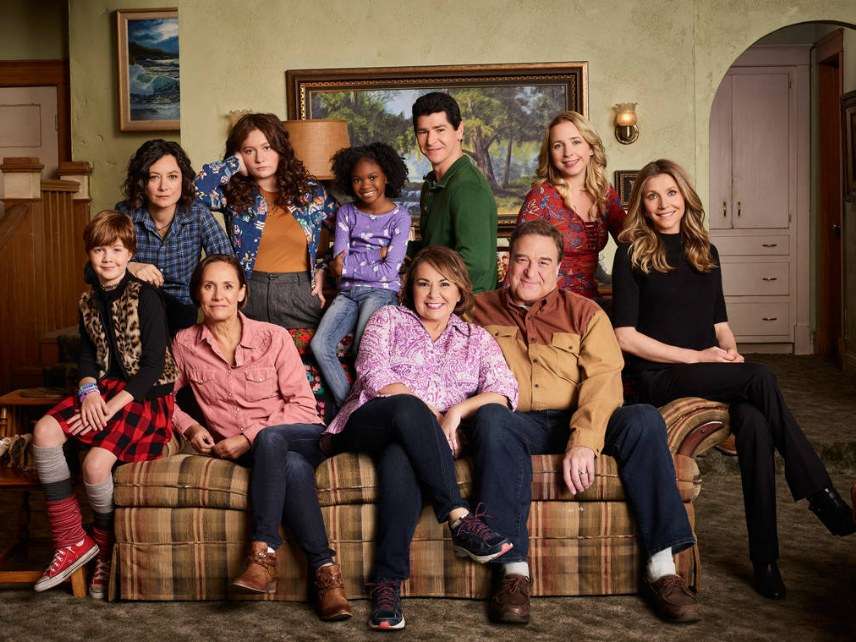Roseanne Returns to Television, Older but Not Necessarily Wiser
Meanwhile a new miniseries on AMC builds a horror mystery out of a failed Arctic expedition.

The Terror. AMC. Monday, March 26, 9 p.m.
Roseanne. ABC. Tuesday, March 27, 8 p.m.
In a 500-channel world where programming demand is sucking Hollywood's creative blood dry, resulting in remakes—S.W.A.T.! Dynasty! Lethal Weapon!—the news that AMC was working on a series called The Terror flipped a lot of lids. This film was the most infamously cheapjack production of any of the 400 or so made by penny-ante director Roger Corman. It was made with production days, sets, and actors swiped from other Corman flicks (including three shooting days extorted from a failing Boris Karloff). It boasted a script written in a single weekend! It had Jack Nicholson tongue-kissing a corpse (severe penalties will be levied on anyone who tells an Anjelica Huston joke here) vying with screen time with a bird that eats people's eyes! Imagine this, week after week, laying waste to the minds of an entire generation.
Well, don't. It turns out The Terror isn't a remake after all but a brand new series based on Dan Simmons' epic "What If?" novel about an altogether real British naval expedition that disappeared in the Arctic in the mid-1840s. And though I still tremble with nihilistic thrill at the depravity potential of a Corman remake for TV, the fact is that AMC's production of The Terror is a slow-burning horror-genre delight.
The voyage upon which The Terror is based set out from Great Britain in 1845 intending to chart the route from the Atlantic to Pacific oceans through the Northwest Passage. But the two ships, the Erebus and the Terror, were caught in the ice and abandoned by their crews, who were never seen again. Reports of Inuit Indian tribes in the area gave rise to rumors of madness, murder and cannibalism; the examination of some skeletal remains discovered 150 years later suggested that at least some of the stories might be true.
Simmons, in his novel, used a Ten Little Indians scenario, with crewmen disappearing from the ship one by one, to launch a book that was much more than a murder mystery. The Terror's writer-director David Kajganich has taken a slightly different route, using the star-crossed expedition's hardships to invite views to wonder if its troubles are super- or supra-natural.
There is evidence for either, or both. Using a remarkable set built in Hungary, Kajganich's cameras emphasize the vast bleakness of the Arctic and its relative imperviousness to the flimsy technology of the day. Even knowing where they were was a major accomplishment for the expedition's leaders; decades before radio or radar, and traversing an area where the magnetic north pole rendered compass results dubious, the ships' navigators had to rely solely on their charts of the stars—when the weather allowed.
The strength of the ice, the unpredictability of weather and ocean currents, and the shortage (and possible contamination) of provisions all conspire against the expedition. Then there's that half-glimpsed-in-the-twilight beast, so improbable that the officers suspect it's a hallucination of their overworked crewmen. Their skepticism also extends to the occasional straggling Inuits they encounter, all warning to run in the face of a nameless dread.
As trouble mounts, one officer declares: "In this place, technology still bends the knee to luck." Retorts another: "This place wants us dead!"
Simmons' novel was originally optioned for a feature film, but the decision to stretch it out to a mini-series was a wise one, allowing The Terror a leisurely development of the crew's growing anxieties. (Whether AMC viewers, accustomed to the rapid brains-eaten-per-minute count of its Walking Dead series, will like the slow-burn pace is another matter.)
The Terror's virtually all-British cast is extraordinarily effective at teasing out the dread, teaspoon by teaspoon, particularly Ciaran Hinds (Game Of Thrones) as the full-speed-ahead commander Sir John Franklin and Jared Harris (Mad Men) as his far more cautious second in command, Francis Crozier. Unlike Corman's, this Terror is worthy of the name.
Fans of cheesy remakes, however, will get their due when Roseannne returns to the air after an 11-year absence. Except—contrary to expectations—it's not cheesy at all. This new version, which returns almost all the major cast members, brings the same rough-and-tumble sensibility to the declining years of baby boomers as the 1988-97 original did to the economic and social tensions of working-class life.
Dan and Roseanne Connor (John Goodman and Roseanne Barr) are back, older but not particularly wiser, facing the problems that have become entirely too familiar to boomers headed into retirement: rising drug prices; the tenuous economics of fixed-income life; the financial failures of their adult kids, resulting in no-longer-empty-nest syndrome; the perplexing gender ambiguity of their grandchildren; and of course, the eternal question, Trump vs. Clinton, with the debate being carried out at bumper-sticker levels of acuity, just as it is on Facebook and Twitter.
With Bruce Helford (The Drew Carey Show) and Whitney Cummings (2 Broke Girls) overseeing the writing, the punchlines come fast and furious. The first episode is perhaps a bit heavy on internal jokes to paper over deviations from show history—particularly the fact that Dan Connor's death during the 1996-97 season was not quite as serious as it looked—but by the second, it's settled into a familiarly brassy and vulgar groove. For instance, here's Roseanne's brief explication on how alcoholism marred her family history: "The ones who didn't drink were killed by the ones who did."

Show Comments (22)